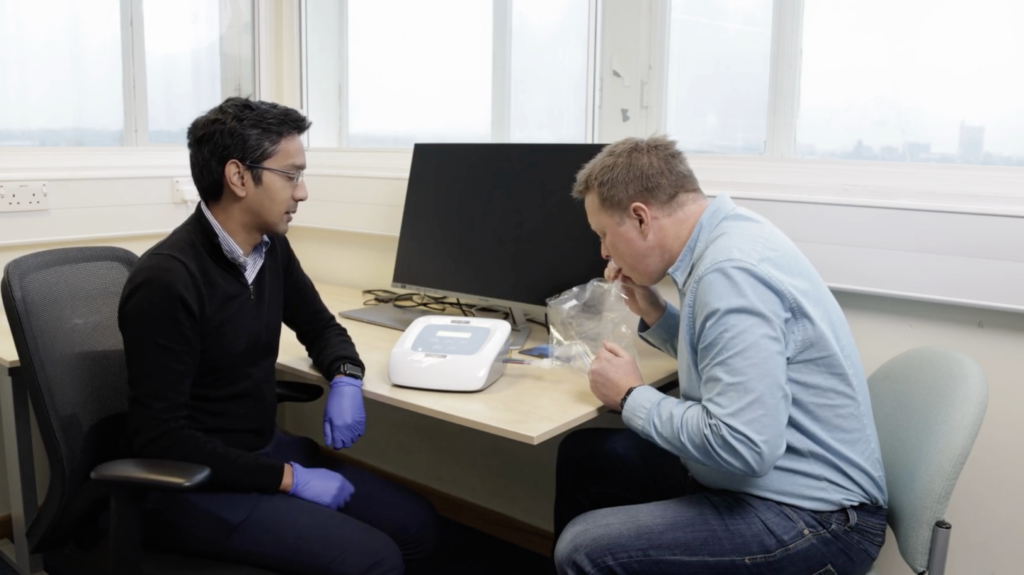Identification and quantification of VOCs by proton transfer reaction time of flight mass spectrometry: An experimental workflow for the optimization of specificity, sensitivity, and accuracy

Proton transfer reaction time of flight mass spectrometry (PTR-ToF-MS) is a direct injection MS technique, allowing for the sensitive and real-time detection, identification, and quantification of volatile organic compounds. When aiming to employ PTR-ToF-MS for targeted volatile organic compound analysis, some methodological questions must be addressed, such as the need to correctly identify product ions, […]
Mass-Spectrometry Analysis of Mixed-Breath, Isolated-Bronchial-Breath, and Gastric-Endoluminal-Air Volatile Fatty Acids in Esophagogastric Cancer

A noninvasive breath test has the potential to improve survival from esophagogastric cancer by facilitating earlier detection. This study aimed to investigate the production of target volatile fatty acids (VFAs) in esophagogastric cancer through analysis of the ex vivo headspace above underivatized tissues and in vivo analysis within defined anatomical compartments, including analysis of mixed […]
Optimisation of sampling parameters for standardised exhaled breath sampling

The lack of standardisation of breath sampling is a major contributing factor to the poor repeatability of results and hence represents a barrier to the adoption of breath tests in clinical practice. On-line and bag breath sampling have advantages but do not suit multicentre clinical studies whereas storage and robust transport are essential for the […]
High-Throughput Breath Volatile Organic Compound Analysis Using Thermal Desorption Proton Transfer Reaction Time-of-Flight Mass Spectrometry

Breath analysis is highly acceptable to patients and health care professionals, but its implementation in clinical practice remains challenging. Clinical trials and routine practice require a robust system for collection, storage, and processing of large numbers of samples. This work describes a platform based upon the hyphenation of thermal desorption (TD) with proton transfer reaction […]
Dumping syndrome after esophagectomy: a systematic review of the literature

In recent years, a steady improvement in survival after radical surgery for esophageal carcinoma has been observed. Earlier detection, refinements in surgical technique, perioperative management, and adjunctive chemo/radiotherapy regimens1,2 have led to a substantial increase in both overall- and disease-free survival, with 40% of patients alive up to 5 years after radical surgery.3
Assessment of a Noninvasive Exhaled Breath Test for the Diagnosis of Oesophagogastric Cancer

The aim of this study was to determine the accuracy of a breath test for the diagnosis of OGC in a multicenter validation study.
Mass-Spectrometry Analysis of Mixed-Breath, Isolated-Bronchial-Breath, and Gastric-Endoluminal-Air Volatile Fatty Acids in Esophagogastric Cancer

A noninvasive breath test has the potential to improve survival from esophagogastric cancer by facilitating earlier detection. This study aimed to investigate the production of target volatile fatty acids (VFAs) in esophagogastric cancer through analysis of the ex vivo headspace above underivatized tissues and in vivo analysis within defined anatomical compartments, including analysis of mixed […]
Profile of exhaled-breath volatile organic compounds to diagnose pancreatic cancer

Pancreatic cancer has a very poor prognosis as most patients are diagnosed at an advanced stage when curative treatments are not possible. Breath volatile organic compounds (VOCs) have shown potential as novel biomarkers to detect cancer. The aim of the study was to quantify differences in exhaled breath VOCs of patients with pancreatic cancers compared […]
Variation in Exhaled Acetone and Other Ketones in Patients Undergoing Bariatric Surgery: a Prospective Cross-sectional Study

Dietary restriction together with alteration of the gastrointestinal tract results in major metabolic changes and significant weight loss in patients undergoing bariatric surgery. Current methods of measuring these changes are often inaccurate and lack a molecular basis. The objective of this study was to determine the role of exhaled ketones as non-invasive markers of nutritional […]
Does mass spectrometric breath analysis detect Pseudomonas aeruginosa in cystic fibrosis?

Pseudomonas aeruginosa associated with increased morbidity and mortality in cystic fibrosis (CF) can be eradicated if detected early; however, prompt detection is problematic in children and non-expectorating adults as oropharyngeal cultures lack sensitivity.


